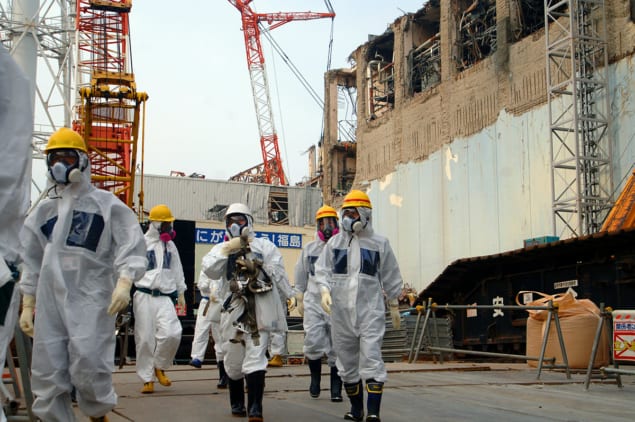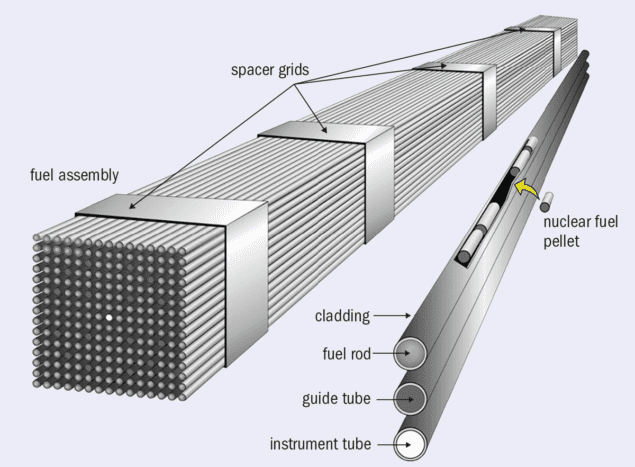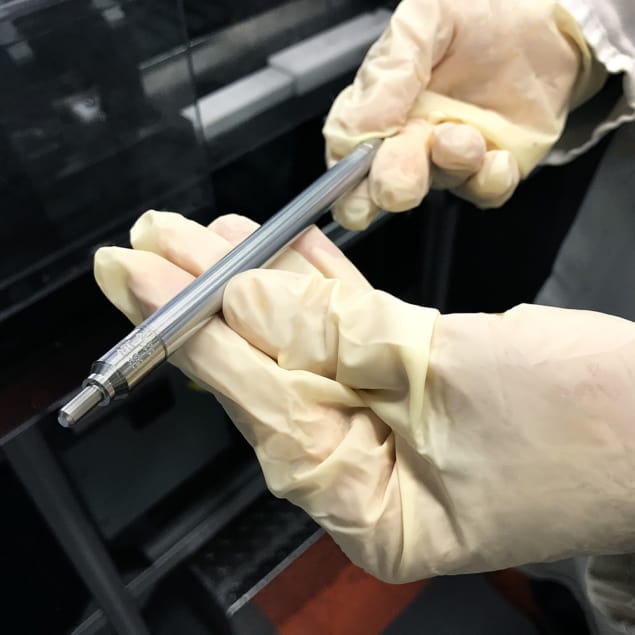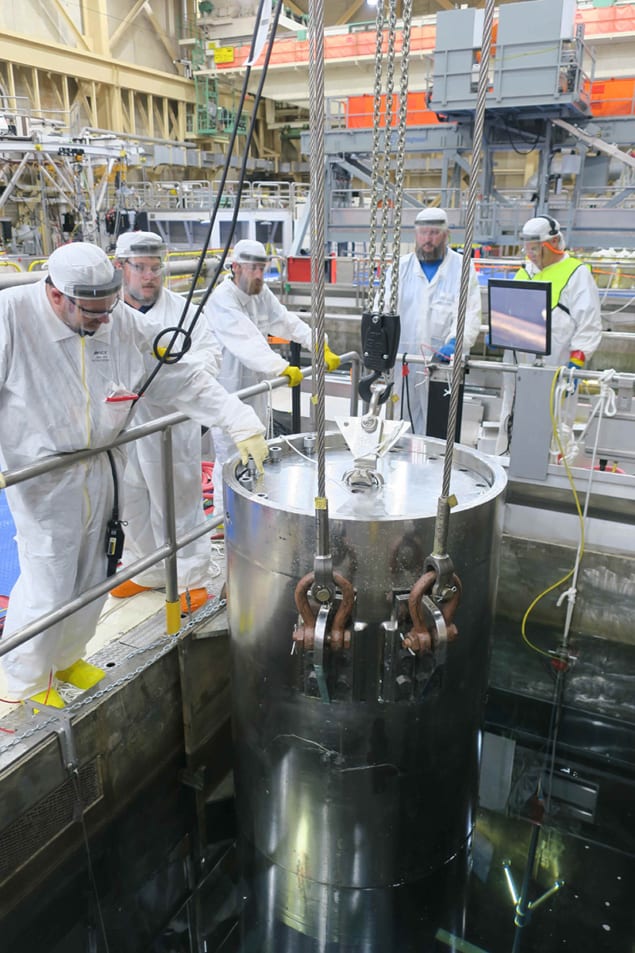
Ten years after Fukushima: could new fuels make nuclear power safer? – Physics World
Author: Michael Allen
Allen, Michael. "Ten years after Fukushima: could new fuels make nuclear power safer?" pysicsworld.com. 23 Feb, 2021.
0 General Document comments
0 Sentence and Paragraph comments
0 Image and Video comments
physicsworld.com
Ten years after Fukushima: could new fuels make nuclear power safer? – Physics World
A decade after the Fukushima disaster, Michael Allen investigates claims from academia and industry that the next generation of nuclear fuels could reduce the risk of similar accidents occurring ever again

At 2.46 p.m. local time on Friday 11 March 2011 a massive earthquake hit north-eastern Japan. Striking 130 km offshore, the complex double quake measured 9.0 on the Richter scale and lasted around three minutes. In that time, a 650 km-long section of the sea floor shifted 10–20 m horizontally, while Japan moved a few metres east and the local coastline subsided half a metre.
Initially the Fukushima Daiichi nuclear power plant – located around 225 km north-east of Tokyo – survived the earthquake. But around 40 minutes later it was engulfed by a 15 m-high tsunami. The three operating reactors had turned off automatically following the earthquake, but the immense wave disabled the emergency diesel generators that were supplying back-up power to the cooling systems. With nothing to cool the reactors, their nuclear fuel cores started to overheat and melt. Powerful hydrogen explosions caused extensive damage to the reactor buildings (shown in photo above) and released radiation and radioactive material.
The worldwide nuclear community engaged in a multi-pronged effort to improve the safety of nuclear reactors.
Brent Heuser, University of Illinois
Following the accident at Fukushima, members of the nuclear industry started working on advanced fuel concepts to increase accident tolerance. Their goal is to create fuels that can tolerate any potential loss of cooling in a reactor, and other adverse events, for longer than current fuels – thereby increasing safety margins. In the US, this initiative was brought together by the Department of Energy (DOE) under its Accident Tolerant Fuel Development Program. Launched in 2012, it aims to have test fuel rods in a commercial reactor by 2022.



“The worldwide nuclear community engaged in a multi-pronged effort to improve the safety of nuclear reactors, which are already very, very safe,” explains Brent Heuser, a nuclear engineer at the University of Illinois, US. “And one of those approaches was to attack a specific problem related to the behaviour of the cladding that encapsulates the uranium-dioxide fuel.”
In most commercial reactors the fuel rods consist of uranium-dioxide fuel pellets stacked inside a long cladding tube made of zirconium alloy. Used as a barrier to protect the pellets, zirconium is very resistant to corrosion under normal operation conditions, in which the fuels rods sit in water at temperatures of around 300 °C. (Being under such high pressure, the water doesn’t boil.) “It’s kind of ironic. Zirconium is one of the most reactive metals, but it performs very, very well in reactors under normal operating conditions,” says Heuser. “Its corrosion behaviour is very good. It is radiation tolerant. It is really the first engineering barrier. And the probability of cladding failure is incredibly remote.”
At very high temperatures zirconium reacts with water to produce hydrogen, which generated the explosions at Fukushima.
Jonathan Cobb, World Nuclear Association
However, if there is a temperature excursion and the water coolant starts to boil, the cladding is exposed to high-temperature steam, which zirconium easily reacts with. It converts rapidly to zirconium oxide and becomes very brittle, which can make it crack and therefore no longer serve as a protective barrier.



This cladding was responsible for the explosions seen during the Fukushima incident, explains Jonathan Cobb, senior communication manager at the World Nuclear Association. “At very high temperatures zirconium reacts with water to produce hydrogen,” he says. “And that hydrogen gas is what generated the explosions that were seen at Fukushima Daiichi.”
Improved claddings



The approach the nuclear industry has settled on for the first generation of accident-tolerant fuels is to coat the cladding, to stop the zirconium from being directly exposed to high-temperature steam during accidents. This is what Heuser’s lab does – it tests chromium coatings on traditional zirconium-based alloy cladding.
“The advantage of improving the existing cladding is that you’re not starting from scratch,” says Heuser. “You’re taking something that’s been proven to work very well under normal operating conditions and you’re putting a coating on it, which represents a very minor perturbation to the normal operating parameters of a reactor, but gives you this built-in defence should a transient occur and the cladding becomes exposed to high-temperature steam.” Heuser’s team has conducted tests both under normal operating conditions and under exposure to high-temperature steam, and the chromium coatings perform well.
Indeed, chromium-coated claddings are now starting to appear in commercial nuclear reactors. As part of the 2012 programme, the DOE contracted three companies to develop accident-tolerant fuels: Framatome, Westinghouse and GE Research. Both Framatome (a French firm) and Westinghouse (from the US) have been developing chromium-coated zirconium-alloy fuel rods. Westinghouse installed test rods featuring their advanced cladding in the Byron Nuclear Generating Station in Illinois in 2019, and the Doel Nuclear Power Station in Belgium in 2020. Meanwhile Framatome’s chromium-coated fuel rods were loaded into a reactor at the Vogtle Electric Generating Plant in Georgia in the US in early 2019. All three reactors are currently using these upgraded rods for a few fuel cycles, after which they will be examined.
Delayed reaction



The aim of accident-tolerant fuels is to delay a reaction during an accident, not prevent it entirely. “The goal is not to say, OK this has happened, we can just let nature take its course and in three days we’re going to be fine,” Heuser says. “That was never the goal. It’s completely unrealistic. The question is: how much time can we buy?” He points out that research suggests that a chromium coating can prevent the high-temperature steam reaction with the underlying zirconium cladding for a couple of hours, which could be enough time for reactor operators to fix the problem.
If you could buy yourself a few hours to get your cooling back under control, then you might save the reactor.
Dave Goddard, National Nuclear Laboratory
As Dave Goddard, the technical lead for the UK’s advanced nuclear fuel programme at the National Nuclear Laboratory (NNL), puts it: “If you could buy yourself a few hours to get your cooling back under control, then you might save the reactor.” But he is unsure if this delay period for chromium-coated rods would be long enough. “A lot of the modelling that’s been done on the chromium-coating concept is suggesting that it may actually be minutes, not hours.”



There are, however, other options, such as changing the cladding material completely. Silicon-carbide composites, a material more akin to a ceramic, are one potential solution currently being looked into. These materials have exceptionally good high-temperature performance. “You can probably reach up to about 800 °C with silicon-carbide cladding before you start seeing any sort of detrimental behaviour,” Goddard explains. But making these composites into 4 m-long tubes with a thin wall is challenging. Currently this is done using a chemical vapour deposition technique that can take weeks, creating problems for the economic viability of the technology. But researchers in the UK, supported by NNL, are working on improving this manufacturing technique.
Meanwhile, the US company GE Research has been developing two products: a new iron-based alloy cladding material known as IronClad, and ARMOR, a coating for zirconium cladding. The ARMOR coating is not chromium, Russ Fawcett – who manages the fuel programme at GE – explains, adding that it is a proprietary product and the company has not disclosed its composition.
As with other accident-tolerant fuel concepts, the aim is to provide time to stabilize a power plant during a severe accident. Fawcett says that in a blackout situation similar to Fukushima’s, research suggests that GE’s cladding products could buy between three and six hours. So far, they have been tested with prolonged exposure to high-temperature steam at GE Research and in reactors at the Idaho National Laboratory in the US, with both products exhibiting improvements in resistance to high-temperature steam compared to the standard zirconium-alloy cladding. In 2018 they were also installed in a commercial reactor at the Hatch Nuclear Power Plant in Georgia in the US, and in 2020 GE performed poolside examinations, which it says showed the prototypes work very well.
The company is now working with the US Nuclear Regulatory Commission to license its ARMOR product for use in nuclear power plants, while development of IronClad will continue. GE hopes to be selling the former by 2025 and the latter four or five years later.
New fuels
Accident tolerance could also potentially be improved by changing the uranium-dioxide pellets that sit inside the cladding tubes.
At Elizabeth Sooby Wood’s lab at the University of Texas at San Antonio, US, researchers are looking at advanced technology fuels. “That’s where we’re getting a better fuel economy or accident-tolerant fuels. And then some products kind of overlap both,” Sooby Wood explains.
When it comes to accident-tolerant fuel, one of the big factors Sooby Wood and her colleagues are looking at is thermal conductivity – that is how efficiently the fuel can dissipate its heat so that it doesn’t reach really high temperatures during adverse incidents. In a reactor, all fuel has to be above a critical temperature. Fuels that are less thermally conductive do not heat up evenly, leading to spots where the fuel is much hotter than the critical temperature.
There are accident scenarios where uranium silicide does perform much better.
Elizabeth Soddy Wood, University of Texas at San Antonio
In contrast, fuels with a higher thermal conductivity can run at a much more even temperature in the reactors, reducing the overall temperature of the fuel and meaning it has further to go from operating temperature to melting point in an accident. The cooler fuel gives you more of a safety margin. “It’s about improving different material families so that they tolerate these abnormal scenarios better,” Sooby Wood says.
Currently her team is looking at uranium silicide as an alternative to the traditional uranium dioxide. On its own, uranium silicide is actually not very accident tolerant – if it is exposed to the reactor coolant it has a worse reaction than uranium dioxide. “But it does have a much higher thermal conductivity,” adds Sooby Wood. “So there are accident scenarios where it does perform much better. We are seeing if we can engineer the uranium silicide to withstand exposure to the coolant.”
Just as materials are added to iron to create stainless steel – a much less corrosive material than plain iron – so the researchers are adding metals to make uranium-silicide alloys. So far, they have been adding both aluminium and chromium. The resulting alloys are tested in a furnace that can go up to 1600 °C, and steam is flowed through to simulate coolant exposure of the fuel elements and the uranium compounds. Ideally there will be no reaction: the uranium-silicide alloys will not degrade or ignite. To date, the researchers have run these steam oxidization tests at temperatures from 200 °C to 1000 °C and the results have been promising, with delayed onset of reaction compared with plain uranium silicide. Now Sooby Wood’s team and others are looking at different ways to incorporate the metals to get further delays.
At this stage, the work is just fundamental research and development, questioning whether alloying works and if it can improve the behaviour of the fuels. But if successful, Sooby Wood says these new fuels could also improve fuel economy as they have a higher uranium density: more uranium per unit volume. “So, for the exact same footprint you have more fissile material. More stuff making power.” This means higher power output from reactors, many of which are currently running at peak capacity. It also leads to longer fuel cycle times.
The higher uranium density could also enable the use of more advanced cladding materials. Sooby Wood explains that some of the cladding materials being looked at have a higher neutron-capture rate than zirconium. This means that they soak up more of the neutrons that are produced and used in fission chain reactions. However, higher-density fuels produce more neutrons in the first place, making this loss less of an issue.
Added benefits
The advanced cladding materials could also improve fuel performance and provide economic benefits. For example, the chromium coatings make the cladding more durable, reducing fuel rod failures and unplanned outages, Goddard says. And GE claims that its new claddings also cut corrosion. Power plants could therefore keep the fuel rods in the reactors for longer, extending fuel cycle lengths and making them more profitable. GE hopes that the improved fuel performance, combined with a slight increase in fuel enrichment, will reduce the number of fuel assemblies a power plant needs by around 10–20%.
Ultimately this could also reduce fuel waste. “If your fuel can be in the reactor for longer, if you have reloads every 18 months instead of every 12 months,” explains Cobb, “then that is going to reduce the already low volumes of used fuel that comes out of the reactors.”
Some experts argue, however, that the pursuit of improved performance and economic benefits is shifting accident-tolerant fuels away from their original aims. Edwin Lyman, director of Nuclear Power Safety at the Union of Concerned Scientists in the US, says that while the idea of accident-tolerant fuels sounds good, he has been disappointed with the results so far. He adds that in the US, industry is moving away from any pretence of improved safety. “Instead, they’re focusing on trying to reduce their operating costs by increasing the burnup and the enrichment of fuels.”
Lyman says extending the coping times by a couple of hours does not make a significant difference to safety – studies suggest that these time frames have a fairly small impact on the probability of a core melt. “I’m not saying it’s of no benefit,” he adds, “but it’s a minimal benefit.”
The US nuclear industry is focusing on trying to reduce their operating costs by increasing the burnup and the enrichment of fuels.
Edwin Lyman, Union of Concerned Scientists
This becomes a real issue when you try to extract more energy from the fuel. By increasing the burnup and keeping the fuel in the reactors for longer you increase the risk of fuel fragmentation and related issues, which could reduce the safety margins in a loss-of-cooling accident, like that at Fukushima. “If you just substituted one of these chromium-coated fuels and didn’t try to increase the burnup, then you might have an additional safety margin,” Lyman says. “But if you push the burnup to the limits of what the fuel can withstand, then you’re not realizing that safety benefit.”

John Allen of GE Research says that while the company will seek to recognize the other benefits of these advanced fuels, “the margin to safety will increase”. His colleague, engineer Evan Dolley, adds: “Our primary objective is to increase fuel reliability and safety, and provide more coping time. We’ve never veered from that.”
Meanwhile, Heuser believes the research and nuclear industry has found a viable solution for accident-tolerant nuclear fuels. “I think the future is bright for nuclear power. And I think it needs to be part of a balanced energy portfolio along with renewables,” he says. “We need to move away from fossil fuels because global climate change is a real problem to address and nuclear power can be and should be part of that solution.”
General Document Comments 0













0 archived comments